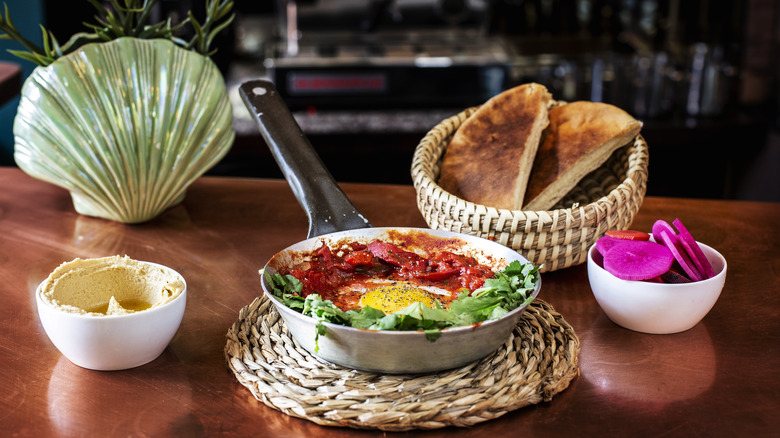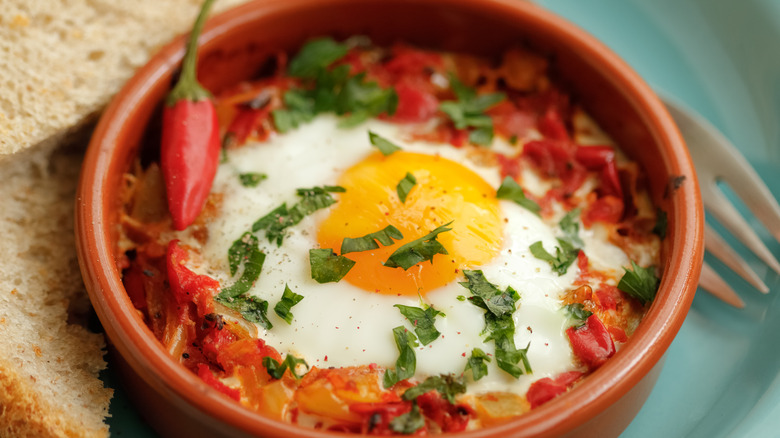The Subtle Differences Between Eggs In Purgatory And Shakshuka
While eggs are generally associated with the most important meal of the day, in other countries eggs are commonly included in many dishes that go beyond your standard breakfast. If you love cracking an egg or two into your ramen or cooking up a well-seasoned quiche for dinner, then you know how versatile this protein-packed fridge staple can really be. For African countries like Morocco and Tunisia as well as some Middle Eastern nations, eggs poached in a saucy tomato base is a savory meal that can be eaten any time of day. However, this dish, called shakshuka, is a name often used interchangeably with Eggs in Purgatory, a popular Italian meal with nearly identical ingredients. Despite their delicious similarities, the key difference lies in the spices used for each.
Regional cuisine dictates which distinct spices and toppings are infused into each of these eggy meals, making the origins of shakshuka one of the main factors that set the dish apart from Eggs in Purgatory. Regardless of which spices you prefer, each requires a gentle simmering of tomatoes in aromatic herbs like garlic, cumin, basil, or paprika before the eggs are cracked into the sauce. Once the egg whites have fully settled as they stew in the tomato sauce, they should come out pillowy soft and can be as runny as you like. After adding garnish, your shakshuka (or its Italian counterpart) is ready to devour as a healthy comfort meal for any time of day. Which flavors are you in the mood for?
Shakshuka is popular in Israel
With a name that means "all mixed up" in Arabic, shakshuka is Israel's favorite breakfast. It's so renowned and popular that it even rivals the country's always-tasty falafel. While its origins are disputed between Yemen, Morocco, and the Ottoman Empire, Israel believes shakshuka has its roots in the North African countries of Libya and Tunisia. Plain and spicy versions are said to have arrived in Israel around the 1960's by way of Jewish immigrants who enjoyed eating shakshuka for its simplicity and affordability. In addition to Eggs in Purgatory, even more variations on the dish have spawned over time, like the traditional Turkish dinner, menemen.
If your goal is to make shakshuka at home, either fresh or canned diced tomatoes will work nicely as the sauce base. You may want to opt for a can of whole peeled tomatoes to add to your skillet, as it adds a sweeter depth to the meal's overall flavor. After a quick sauté of onions and garlic in olive oil, you'll mix in tomato paste and heat for a minute or so before adding in all your spices. Shakshuka is typically seasoned with a fragrant blend of paprika, cumin, and coriander before the sauce is left to simmer for about 15 minutes. After cooking the eggs in the skillet with the rest of the ingredients, top it with parsley and eat it right away with a side of pita or naan bread.
Eggs in Purgatory adds an Italian kick
Often thought of as the Italian version of shakshuka, Eggs in Purgatory is basically the same exact dish, but instead, it's seasoned with herbs usually found in many staples of Italian cuisine. Its recipe swaps out shakshuka's warmer spices for options like basil and oregano, along with a dash of cracked red pepper flakes for a fiery kick. Speaking of fire, if you're wondering how this common Italian breakfast got its name, it's all based on the visuals presented in the finished product. The red, slightly spicy tomato sauce represents the fires of Purgatory, while the eggs hiding in the skillet's sauce pockets are the ill-fated souls trapped within. (However, it's pretty easy to forget about such an ominous name when you take that first bite.)
Called Uova in Purgatorio in its country of origin, we have the Southern Italian city of Naples to thank for this saucy entrée. This makes a lot of sense, considering Naples also happens to be the birthplace of one of the world's favorite saucy foods — pizza. Eggs in Purgatory is also eaten with crusty bread on the side to soak up the additional sauce, usually in the form of ciabatta or focaccia.
Potatoes, meats, and cheeses such as feta or Parmigiano Reggiano are all optional ingredients you might consider adding to boost the overall body and flavor of each of these regional meals. Its versatility is exactly what makes these spice-heavy, oozy egg delicacies so great.


